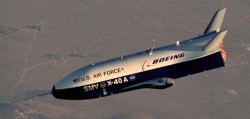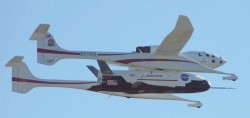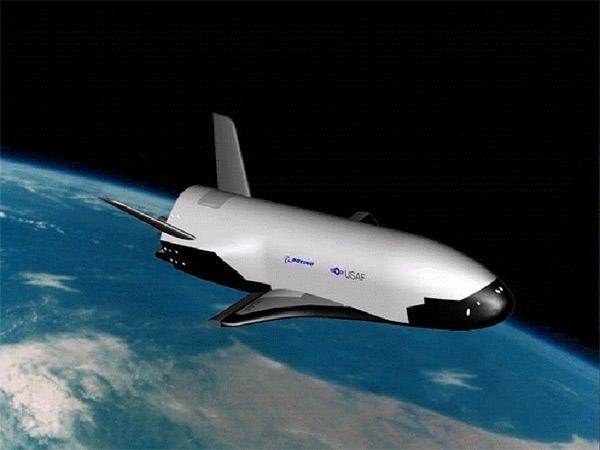[/caption]
It looks like a US Air Force robotic orbiter will push back the planned launch date of NASA’s Lunar Reconnaissance Orbiter (LRO) and Lunar Crater Observation and Sensing Satellite (LCROSS). The double satellite launch, originally set for November this year, will now take place sometime early 2009. They will make way for the test flight of the orbital Boeing X-37B spaceplane, commandeering the Atlas V rocket flight originally intended for NASA. According to the Air Force, the November X-37B test flight will be a study into “risk reduction, experimentation, and operational concept development for reusable space vehicle technologies.” (There might also be some urgency due to the Shuttle decommissioning in 2010…)

The X-37B’s predecessors have undergone exhaustive testing. Based at Edwards Air Force Base, California, the US military has been testing automated spaceplanes for many years. NASA has also been heavily involved in the program. Originally tasked with developing a Space Manoeuvre Vehicle (SMV) that could either be launched by the Shuttle or by rocket, the US Air Force wanted an automated orbital vehicle that could carry out a multitude of tasks in space for up to a year. The X-40 design evolved and by 1998, the vehicle was being dropped from helicopters and allowed to land like a conventional aircraft (automatically). The X-40 military program was then passed to NASA to use as the basis of the X-37 program. After a long period of development, the X-37A was used in conjunction with Scaled Composites WhiteKnightOne (pictured below).

Now the brand new Boeing X-37B is ready to be launched to begin its first automated orbital operations, re-enter and land conventionally. The Atlas V rocket will blast off from Cape Canaveral and the X-37B will hopefully land on schedule at Edwards Air Force Base. The X-37B is 27 ft (8 m) long with a 15 ft (4.5 m) wingspan and resembles a blindfolded mini-Shuttle (it really does! See the picture at the top of the article).
Although there will be a lot of anticipation for the X-37B test flight, it is a shame for the lunar mission scientists who are currently preparing the LRO and LCROSS for their trip to the Moon. The LRO’s objective is to orbit the Moon, analysing the surface to aid future manned missions. LCROSS has something a little more spectacular planned; it will create two impact plumes during it’s kamikaze mission in aid of detecting present water in the lunar rock.
Sources: Gizmodo, Aviation Week, Design Systems


I think LRO ran into delays on their own and had to postpone. X-37 has always been there.
Your title seems a bit misleading. My understanding is that the switch in launch dates has a lot more to do with easing the schedule for LRO and LCROSS which were at risk of delays, than it does the X-37 pushing its way forward.
Have I already mentioned that I love Ian O’Neill articles…? 🙂
Ian – Don’t take it personally… I’m serious.. I do.. Looking forward to more. You always seem to make me come back for more…
I think this site is a notch above all of the rest, and you (Ian) a contributing factor….. Sincerely..
So… this is a new space shuttle?
Granted, its autonomous. But in light of the space shuttles retirement it sounds a hell of alot more interesting than that lunar probe.
It’s more like European ATV (Jules Verne) than space shuttle.
Funny tho… Without war against terrorism, USA would have 2 or 3 new shuttles already in operative use… But no, mr Bush had to cancell the whole thing. 🙁
Can a X-37 stack reach orbit if launched by White Knight Two ?
does the USAF really need another weapons delivery platform??? Im surprised the article doesnt mention that role at all…
I’d be surprised if they bought a system that couldn’t launch weapons… although I’m fairly certain its not that they want to use it for.
The problem is they have a vast fleet of satellites to tend to but do not want to have all their operations covered on the TV news.
The size, cost, and age of the shuttles have made them obsolete and less than ideal for air force work.
What they want is a ship that can go up, run an extended mission, and then return to some nameless airfield with as little attention as possible.
What they have now might be just the thing.
A secretive spacecraft project is being moved from a darpa hanger to the launch pad, and the news media does not seem to give a damn.
If they didn’t cross paths with the LRO, even space watchers may not have known the X-37 was going operational until after the fact. We would have just been told it was another “weather satellite”.
Discretion is the name of the game, and the Airforce appears to be winning.
“But in light of the space shuttles retirement it sounds a hell of alot more interesting than that lunar probe.”
It’s not a cheaper, faster, or safer way of getting into space, it’s a way for the military to service their satellites without compromising security. I doubt the Shuttle has the slightest bit to do with it…it’s always had extremely limited capabilities in terms of the orbits it could reach, and we’ve been unwilling to use it to even those limits after Colombia, almost abandoning the Hubble telescope because the Shuttle wouldn’t have been able to reach the ISS if it needed to following a Hubble service mission.
So overall, I’d be far more interested in the moon probe. It’s much more relevant to our future.
Servicing satellites? The only thing of any consequence I can think of is this thing could lift a satellite out of a decaying orbit. I’m sure this is going to save us a lot of money versus replacing expensive military satellites. But… I bet ya the secret to this thing is that they launch it with a man or two on board. Certainly not for a long mission like a year, or even a month, but how else are they going to do a complex servicing mission?
They can do a seemingly complex mission by designing the target satellite to be modular and serviceable with a robot arm.
Hooking up hoses and swapping out blocks of instruments and consumables would extend the life of a satellite, and not require the use of human hands.
With its flight range being so long (9 months?) I suspect they can also rig the shuttle itself as a reconnaissance satellite. One with aerobraking and return abilities.
Turning it into a space bomber is not out of the question, but they could do that with the current launch systems easily enough.
Its all based on technology born for nuclear war, after all.
ASM’s would be cool too – anti-satellite missles.
Hmmm – I think I saw this on Discovery, but it’s been years, so forgive my ingnorance:
Wasn’t there an X-design with lifting body + aerofoil decent designed and tested about a decade ago? It was decomissioned back when Space was not considered economically interesting – much like now, really.
It looked a lot more elegant than this thing.
l mc
My thoughts as well.
While officially the role of this craft may be to service satellites, reconaisance etc, there is no doubt a huge amount of operational utility data will be studied as well for future designs.
A rather scary thought for any nation is a LEO constellation of these crafts full of cruise missiles. An aggressive orbit change out of radar range could provide near zero warning of an attack and at speeds far above any defensive reaction time.
I can think of quite a few military platforms this item could evolve for.
A little shocking the Russian Government has a problem with defensive missiles in Europe, but hasn’t really made a sound about this. Could we be seeing a Russian version soon?
I live in Florida and can’t wait to watch the launch of this thing next month. I would rather be at Edwards, Mojave, or even as some suspect Vandenburg to watch the landing. So far as those who suspect men will be aboard this thing, forget it. The entire vehicle is less than 28 feet long, and its size and shape comes from the originally designed plan to launch it in space from the payload bay of a Space Shuttle. The major difference is the lift to orbit, and the vehicle will reach orbit shrouded by a composite nosecone atop the rocket for no good reason other than to protect the Air Force’s interest in keeping the launch as classified as possible. This seems rather ridiculous to me as there are no major changes from the days this was a program funded by and sponsored by NASA at which time NASA kept no secrets either about the size of or performance of the vehicle. See http://www.nasa.gov/centers/dryden/home/index.html and look for the X-37 and X-40 programs and the great videos especially of the X-40.
The X-37B will follow the same reentry path the Shuttle follows … it will come in on a gradual horizontal entry path starting half a world away, slowly losing altitude and speed up to about the 50,000 foot level at which time air will be thick enough for winged flight to take over from what is basically a computer-controlled attitude entry with the primary movement made through RCS rockets and not conventional airframe controls such as wings or flaps. The horizontal flight then becomes much more a vertical one, somewhat dropping like a lawn dart so as to maintain the “pre-flare” airspeed as the vehicle (Shuttle or X-37B) has no engines and has to have a lot of “energy” so as to not “stall” like most aircraft without power would do with the engines off. The aim point in this near free-fall is a half mile short of the target threshhold on the runway, and at about 1,000 feet with adequate pre-flare airspeed the craft will pitch the nose up, lower the landing gear, and make a smooth unpowered landing.
The question with the X-37B is not whether automated computers on board and external microwave signals can successfully land the craft. As a matter of fact most Shuttle landings can and are in fact performed without actual pilot control except for when the ego of the humans at the flight station demand physical control, mostly during the “HAC” turns. In the few times pilots actually overrode the computers during Shuttle landings, the result was almost always porpoising and a loss of control that nearly resulted in very bad results. So the question is not whether automated controls – or even controls of robots from some ground trailer can effectively do everything in space that humans are required to do now. The question is just about the ego involved and the costs and expensive overhead for redundancy and safety involved wherever humans fly aboard such craft.
Another poster asked about the lifting body vehicle made almost entirely of composites. It was the X-38 which was the prototype for what NASA had hoped would be the CRV or Crew Return Vehicle. Like the upcoming X-37B launch, the X-38 would have gone up atop a disposable rocket and it was to serve as the Space Station’s “Lifeboat” capable of landing 7 (and not the 3 the Russian escape lifeboat is capable of) Astronauts in an emergency. There were really no technical challenges to this program and work was well underway for the first operational model before it was cancelled by NASA as a victim of internal budget priorities. The X-38 was an almost precise replica of the earlier X-23A which did make a conventional landing using Shuttle approaches and deployable landing gear. The X-23A was also a manned vehicle. But X-38 test vehicles were not. They were controlled by a gaming joystick in a NASA trailer, and while in a fall a square chute was deployed to bring the vehicle slowly to a stop on deployable landing skids.